Marianne's Arctic Xpress supports World Cancer Day by donating 50% of the price paid on all bookings Feb. 3-5 to cancer research. Arctic clothing and semi-pro cameras included. Groups of 2 to 8 welcome. Book Now | | |
AN UPTICK IN SOLAR ACTIVITY: After weeks of no solar flares, there have been half a dozen in the past 24 hours. The source of the activity is two new sunspots emerging in the sun's northern hemisphere: AR2527 and AR2528. The magnetic canopy of these sunspots is crackling with C-class solar flares. NASA's Solar Dynamics Observatory recorded this one (C9.3) on Jan 21st at 0726 UT:
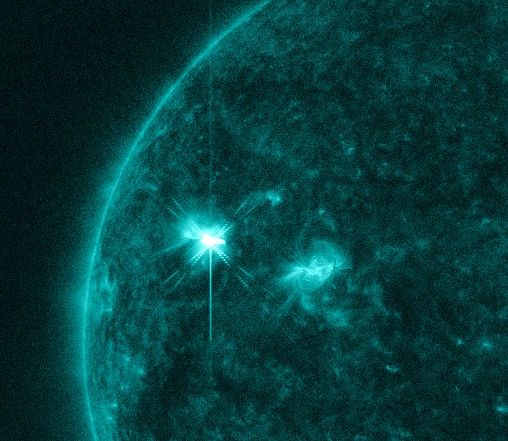
It is important to note that these are not major flares. The strongest so far has registered C9 on the Richter Scale of Solar Flares. During Solar Maximum, such a puny flare would not be mentioned as busy space weather forecasters tracked explosions 100x more potent. But now, with sunspot counts so low and flares so seldom, a C9 event is noteworthy.
Extreme UV radiation from C-class flares can produce minor waves of ionization in Earth's upper atmosphere and interfere with the normal propagation of shortwave radio signals--mainly at frequencies 10 MHz and below. Stronger flares could be in the offing as sunspot complex AR2627-2628 continues to grow. Stay tuned for updates.
Realtime Space Weather Photo Gallery
RADIATION CLOUDS AT AVIATION ALTITUDES: A new study published in the peer-reviewed journal Space Weather reports the discovery of radiation "clouds" at aviation altitudes. When airplanes fly through these clouds, dose rates of cosmic radiation normally absorbed by air travelers can double or more.
"We have flown radiation sensors onboard 264 research flights at altitudes as high as 17.3 km (56,700 ft) from 2013 to 2017," says Kent Tobiska, lead author of the paper and PI of the NASA-supported program Automated Radiation Measurements for Aerospace Safety (ARMAS). "On at least six occasions, our sensors have recorded surges in ionizing radiation that we interpret as analogous to localized clouds."

The fact that air travelers absorb radiation is not news. Researchers have long known that cosmic rays crashing into Earth's atmosphere create a spray of secondary particles such as neutrons, protons, electrons, X-rays and gamma-rays that penetrate aircraft. 100,000 mile frequent flyers absorb as much radiation as 20 chest X-rays—and even a single flight across the USA can expose a traveler to more radiation than a dental X-ray.
Conventional wisdom says that dose rates should vary smoothly with latitude and longitude and the height of the aircraft. Any changes as a plane navigates airspace should be gradual. Tobiska and colleagues have found something quite different, however: Sometimes dose rates skyrocket for no apparent reason.
"We were quite surprised to see this," says Tobiska.
All of the surges they observed occurred at relatively high latitudes, well above 50 degrees in both hemispheres. One example offered in their paper is typical: On Oct 3, 2015, an NSF/NCAR research aircraft took off from southern Chile and flew south to measure the thickness of the Antarctic ice shelf. Onboard, the ARMAS flight module recorded a 2x increase in ionizing radiation for about 30 minutes while the plane flew 11 km (36,000 feet) over the Antarctic Peninsula. No solar storm was in progress. The plane did not abruptly change direction or altitude. Nevertheless, the ambient radiation environment changed sharply. Similar episodes have occurred off the coast of Washington state.
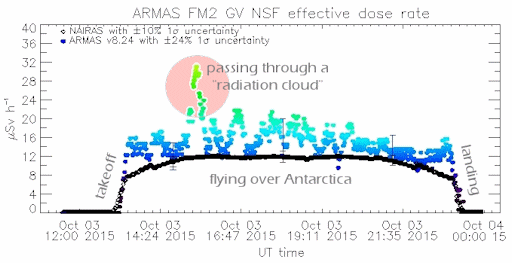
Above: Radiation measurements made by ARMAS while flying over Antarctica. The colored points are from ARMAS. The black points are from a NASA computer model (NAIRAS) predicting radiation dose rates. Throughout the flight, ARMAS observed higher dose rates than predicted by the model, including a surge highlighted in pink.
What's going on?
"We're not sure," says Tobiska, "but we have an idea."
Earth's magnetic field, he explains, traps many cosmic rays and solar energetic particles in structures called "magnetic bottles." These bottles can be leaky. Even minor gusts of solar wind can cause the trapped particles to squirt out the ends of the bottle, sending beams of particles down toward the Earth below.
"Basically, we think we might be flying through some of these leaky particle beams," says Tobiska.
Tobiska notes that a team of South Korean researchers has observed similar variations in radiation while flying sensors onboard a military aircraft near the border between the two Koreas (Lee et al 2015). If the phenomena are the same, the Korean measurements would suggest that "radiation clouds" may exist at middle latitudes, too.
The ARMAS program has a busy flight schedule in 2017. "We'll be looking carefully for more 'clouds' as we continue to characterize the radiation environment at aviation altitudes," says Tobiska.
Stay tuned for updates and, meanwhile, read Tobiska et al's original research at this URL: http://onlinelibrary.wiley.com/doi/10.1002/2016SW001419/abstract
Sharable permalink to this article: Radiation Clouds at Aviation Altitudes
SUNSET IN THE STRATOSPHERE: Nothing says "I love you" like a bear from space. To raise money for their cosmic ray research program, the students of Earth to Sky Calculus have flown a payload-full of Valentine's bears to the edge of space. This was a special flight, timed to photograph the bears at sunset in the stratosphere, wrapped in the romantic light of the fading sun 98,000 feet above Earth's surface:

You can have one for $49.95. Each bear comes with a Valentine's card showing the bears in flight and telling the story of their trip to the stratosphere.
More far-out Valentine's gifts may be found in the Earth to Sky store. All proceeds support cosmic ray balloon flights and STEM education.
Realtime Aurora Photo Gallery
Realtime Airglow Photo Gallery
Realtime Sprite Photo Gallery
Every night, a network of
NASA all-sky cameras scans the skies above the United States for meteoritic fireballs. Automated software maintained by NASA's Meteoroid Environment Office calculates their orbits, velocity, penetration depth in Earth's atmosphere and many other characteristics. Daily results are presented here on Spaceweather.com.
On Jan. 21, 2017, the network reported 4 fireballs.
(4 sporadics)
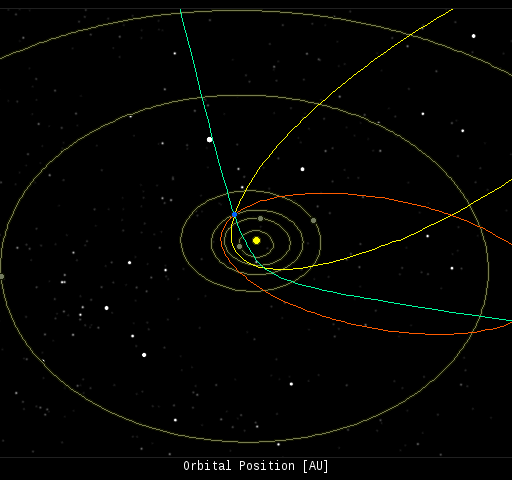
In this diagram of the inner solar system, all of the fireball orbits intersect at a single point--Earth. The orbits are color-coded by velocity, from slow (red) to fast (blue). [Larger image] [movies]
Potentially Hazardous Asteroids (
PHAs) are space rocks larger than approximately 100m that can come closer to Earth than 0.05 AU. None of the known PHAs is on a collision course with our planet, although astronomers are finding
new ones all the time.
On January 21, 2017 there were potentially hazardous asteroids.
Notes: LD means "Lunar Distance." 1 LD = 384,401 km, the distance between Earth and the Moon. 1 LD also equals 0.00256 AU. MAG is the visual magnitude of the asteroid on the date of closest approach. | | Cosmic Rays in the Atmosphere |
Readers, thank you for your patience while we continue to develop this new section of Spaceweather.com. We've been working to streamline our data reduction, allowing us to post results from balloon flights much more rapidly, and we have developed a new data product, shown here:
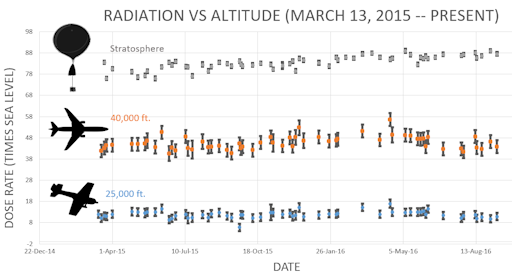
This plot displays radiation measurements not only in the stratosphere, but also at aviation altitudes. Dose rates are expessed as multiples of sea level. For instance, we see that boarding a plane that flies at 25,000 feet exposes passengers to dose rates ~10x higher than sea level. At 40,000 feet, the multiplier is closer to 50x. These measurements are made by our usual cosmic ray payload as it passes through aviation altitudes en route to the stratosphere over California.
What is this all about? Approximately once a week, Spaceweather.com and the students of Earth to Sky Calculus fly space weather balloons to the stratosphere over California. These balloons are equipped with radiation sensors that detect cosmic rays, a surprisingly "down to Earth" form of space weather. Cosmic rays can seed clouds, trigger lightning, and penetrate commercial airplanes. Furthermore, there are studies ( #1, #2, #3, #4) linking cosmic rays with cardiac arrhythmias and sudden cardiac death in the general population. Our latest measurements show that cosmic rays are intensifying, with an increase of more than 12% since 2015:
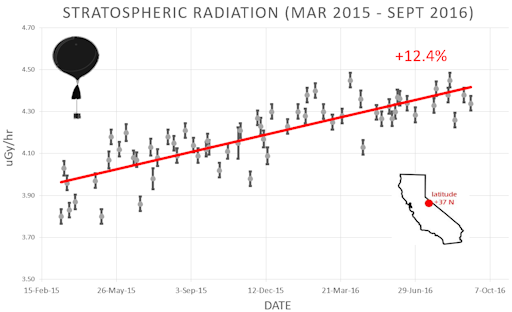
Why are cosmic rays intensifying? The main reason is the sun. Solar storm clouds such as coronal mass ejections (CMEs) sweep aside cosmic rays when they pass by Earth. During Solar Maximum, CMEs are abundant and cosmic rays are held at bay. Now, however, the solar cycle is swinging toward Solar Minimum, allowing cosmic rays to return. Another reason could be the weakening of Earth's magnetic field, which helps protect us from deep-space radiation.
The radiation sensors onboard our helium balloons detect X-rays and gamma-rays in the energy range 10 keV to 20 MeV. These energies span the range of medical X-ray machines and airport security scanners.
The data points in the graph above correspond to the peak of the Reneger-Pfotzer maximum, which lies about 67,000 feet above central California. When cosmic rays crash into Earth's atmosphere, they produce a spray of secondary particles that is most intense at the entrance to the stratosphere. Physicists Eric Reneger and Georg Pfotzer discovered the maximum using balloons in the 1930s and it is what we are measuring today.
| | The official U.S. government space weather bureau |
| | The first place to look for information about sundogs, pillars, rainbows and related phenomena. |
| | Researchers call it a "Hubble for the sun." SDO is the most advanced solar observatory ever. |
| | 3D views of the sun from NASA's Solar and Terrestrial Relations Observatory |
| | Realtime and archival images of the Sun from SOHO. |
| | from the NOAA Space Environment Center |
| | a proud supporter of science education and Spaceweather.com |
| | the underlying science of space weather |
 | Beautyz for top beauty products reviews and their buying guides |
| | These links help Spaceweather.com stay online. Thank you to our supporters! |

